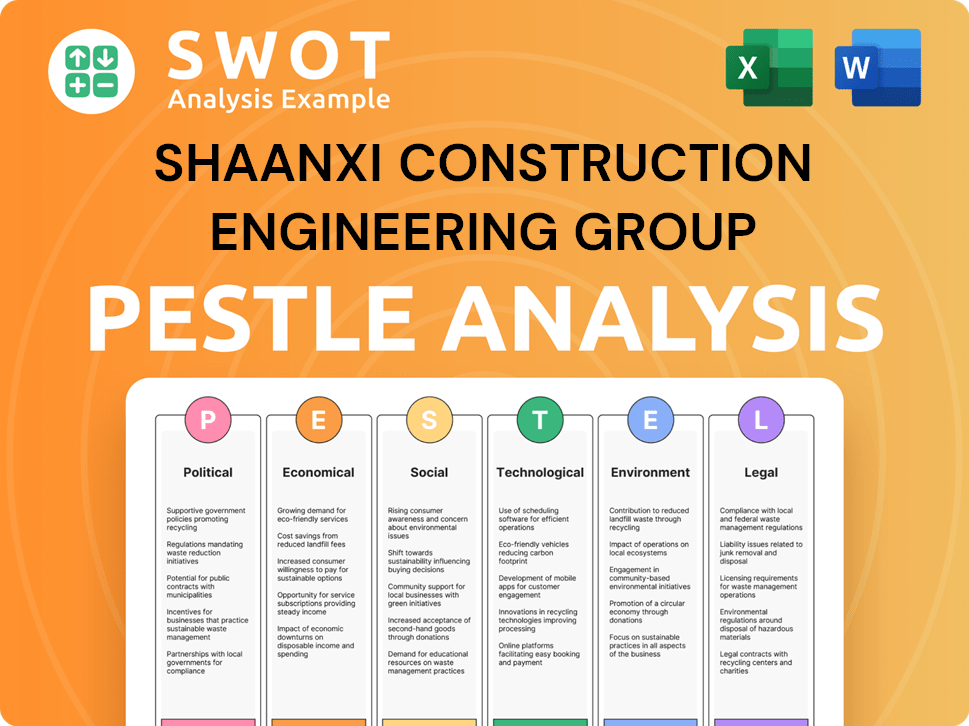Shaanxi Construction Engineering Group Bundle
Who Really Owns Shaanxi Construction Engineering Group Company?
Unraveling the ownership of a construction giant like Shaanxi Construction Engineering Group Company (SCEG) is crucial for understanding its strategic moves and market position. The ownership structure of any Shaanxi Construction Engineering Group SWOT Analysis is a cornerstone of its operational accountability and influence. As a key player in China's construction sector, SCEG's ownership story is more than just a corporate detail; it's a reflection of China's economic evolution.

Understanding the ownership of Shaanxi Construction, a prominent construction company, is key to grasping its operational strategies and future prospects. This Company Profile will explore the evolution of SCEG's ownership, from its state-backed origins to its current structure. By examining its ownership, we can better understand its role in the Chinese construction landscape and its alignment with national economic objectives. Exploring the ownership structure of Shaanxi Construction Engineering Group Company reveals insights into its governance, strategic direction, and potential for growth.
Who Founded Shaanxi Construction Engineering Group?
The Shaanxi Construction Engineering Group Company (SCEG) was established in 1950, marking its entry into the construction industry. As a state-owned enterprise (SOE), its inception differed significantly from privately held companies. The primary goal was to support the national reconstruction and industrialization efforts of the People's Republic of China.
The Shaanxi Construction was not founded by individual entrepreneurs but by the central and provincial governments of China, specifically the Shaanxi Provincial People's Government. This setup meant there were no individual founders with specific equity splits or shareholdings, unlike private corporations. The company's formation was a direct instrument of the state, designed to fulfill national construction mandates.
Initially, the government allocated the company's assets and operational capital, with strategic direction entirely dictated by state planning. Funding came directly from state budgets and economic development funds. The founding team comprised government officials and planning committees whose vision aligned with broader national development goals, focusing on infrastructure and urban development within Shaanxi province and beyond.
The ownership of Shaanxi Construction Engineering Group Company (SCEG) is vested in the state, specifically the Shaanxi Provincial People's Government. This structure is typical for SOEs in China, where the government maintains control to align the company's objectives with national economic policies and development plans. The company's operations are overseen by the State-owned Assets Supervision and Administration Commission (SASAC) of the Shaanxi Provincial People's Government. This ensures that the company adheres to state policies and contributes to the region's economic growth.
- The Shaanxi Provincial People's Government holds the ultimate ownership and control.
- SASAC of the Shaanxi Provincial People's Government supervises operations.
- The primary objective is to serve public interests and national economic plans.
- The company's structure reflects its role in supporting national infrastructure and development goals.
Shaanxi Construction Engineering Group SWOT Analysis
- Complete SWOT Breakdown
- Fully Customizable
- Editable in Excel & Word
- Professional Formatting
- Investor-Ready Format

How Has Shaanxi Construction Engineering Group’s Ownership Changed Over Time?
The ownership of Shaanxi Construction Engineering Group Company (SCEG) is primarily controlled by the Shaanxi Provincial People's Government. As a state-owned enterprise (SOE), its ownership structure is less about market-driven investments and more about government directives and administrative restructuring. The State-owned Assets Supervision and Administration Commission (SASAC) or its provincial equivalent plays a key role in overseeing the company's operations and strategic direction. Unlike publicly traded companies, SCEG's capital structure is managed through state allocations and retained earnings, all under governmental oversight.
Recent trends in China's SOE reforms, particularly in 2024 and 2025, have focused on improving corporate governance and introducing market mechanisms. This may include establishing more independent boards of directors or introducing strategic investors, often other SOEs or state-backed funds. However, the core control remains with the Shaanxi provincial government, ensuring alignment with regional development strategies and national economic objectives. Any changes in ownership structure are typically driven by the government's strategic goals, such as enhancing efficiency or promoting mixed-ownership reforms. For more insights, you can read about the Growth Strategy of Shaanxi Construction Engineering Group.
| Ownership Aspect | Details | Impact |
|---|---|---|
| Primary Owner | Shaanxi Provincial People's Government | Ensures alignment with regional and national economic objectives. |
| Control Mechanism | State-Asset Management Commissions (SASAC) | Oversees operations, strategic direction, and implementation of reforms. |
| Capital Structure | State allocations, strategic investments, and retained earnings | Managed under government oversight, not subject to market fluctuations. |
As of late 2024 and early 2025, the emphasis remains on refining corporate governance and introducing market-oriented practices within the SOE framework. This includes potentially bringing in strategic investors, often other SOEs or state-backed funds, to enhance operational efficiency and transparency. The Shaanxi Provincial People's Government's continued control ensures that SCEG's activities are closely aligned with regional development plans and broader national economic strategies. These changes aim to improve the company's competitiveness and adaptability while maintaining its strategic importance.
Shaanxi Construction Engineering Group Company (SCEG) is a state-owned enterprise.
- The Shaanxi Provincial People's Government holds primary ownership.
- Ownership changes are driven by government directives, not market investments.
- Recent reforms focus on improving governance and introducing market mechanisms.
- Strategic investors may be introduced, but government control remains central.
Shaanxi Construction Engineering Group PESTLE Analysis
- Covers All 6 PESTLE Categories
- No Research Needed – Save Hours of Work
- Built by Experts, Trusted by Consultants
- Instant Download, Ready to Use
- 100% Editable, Fully Customizable

Who Sits on Shaanxi Construction Engineering Group’s Board?
The Board of Directors of Shaanxi Construction Engineering Group Company (SCEG), a significant construction company, is structured to reflect its status as a state-owned enterprise (SOE). While specific details on the current board members, their affiliations, and voting power percentages for 2024-2025 are not readily available in public records, the board typically includes senior executives from within the company, representatives from the Shaanxi Provincial People's Government or its state-asset management arm, and potentially a limited number of independent directors. This composition ensures alignment with governmental oversight and strategic directives.
The board's structure is designed to ensure that the company's operations and strategic decisions align with state economic plans and policy objectives. Voting power is concentrated within the governmental oversight framework, rather than following a 'one-share-one-vote' principle. Decisions are made through a combination of executive leadership, party committee directives, and board resolutions, all of which reflect state policy. Recent years have seen efforts to improve corporate governance within Chinese SOEs, including enhancing the role of independent directors and streamlining decision-making processes, but these reforms operate within the overarching framework of state control.
| Board Member Role | Typical Affiliation | Voting Power Dynamics |
|---|---|---|
| Chairman/CEO | Senior Executive of SCEG, Party Committee Member | Significant influence, aligned with state directives |
| Government Representatives | Shaanxi Provincial Government or SASAC | Key decision-making, ensuring policy alignment |
| Independent Directors | External Professionals | Advisory role, contributing to governance |
The ultimate decision-making authority rests with the provincial government, which appoints and oversees the board to ensure the company fulfills its mandate as a key state-owned construction entity. Proxy battles or activist investor campaigns, common in Western markets, do not occur within Shaanxi Construction Engineering Group Company due to the absence of dispersed private shareholders. Any governance controversies would typically involve internal disciplinary actions or audits related to compliance with state regulations and performance targets. The focus remains on aligning the company’s activities with the strategic goals of the Shaanxi province and the broader national economic agenda, with the board acting as the primary instrument for achieving this alignment.
The Board of Directors of Shaanxi Construction Engineering Group Company is primarily composed of senior executives, government representatives, and independent directors.
- Voting power is concentrated within the governmental oversight framework.
- Decisions are made through executive leadership, party committee directives, and board resolutions.
- The provincial government appoints and oversees the board to ensure alignment with state objectives.
- Governance controversies typically involve internal actions related to compliance and performance.
Shaanxi Construction Engineering Group Business Model Canvas
- Complete 9-Block Business Model Canvas
- Effortlessly Communicate Your Business Strategy
- Investor-Ready BMC Format
- 100% Editable and Customizable
- Clear and Structured Layout

What Recent Changes Have Shaped Shaanxi Construction Engineering Group’s Ownership Landscape?
Over the past few years, the ownership of Shaanxi Construction Engineering Group Company (SCEG) has been primarily influenced by China's state-owned enterprise (SOE) reforms. As an SOE, the Company Profile reflects the goals of enhancing operational efficiency and strengthening corporate governance. While specific financial details for 2024-2025 aren't publicly available, the trend for large provincial SOEs like Shaanxi Construction has involved exploring mixed-ownership models. This might include bringing in state-backed institutional investors or partial listings of subsidiaries to diversify capital and improve market competitiveness. However, the Shaanxi Provincial People's Government maintains the controlling stake.
The construction sector in China, particularly for SOEs, is focusing on international expansion and investing in advanced construction methods, smart cities, and green building. These strategic shifts are supported by government policy, reinforcing the state's role as the primary owner and strategic driver. Leadership changes at SCEG are administrative appointments rather than ownership-driven transitions. Discussions regarding future ownership changes for such entities usually revolve around further corporatization, asset securitization, or integration with other state-owned entities to create larger, more competitive conglomerates, rather than a move towards full privatization.
| Aspect | Details | Status (2024-2025) |
|---|---|---|
| Ownership Structure | Primary owner | Shaanxi Provincial People's Government |
| Strategic Focus | Key initiatives | International expansion, high-tech construction, green building |
| SOE Reforms | Impact | Enhanced operational efficiency, improved corporate governance |
The strategic direction of Shaanxi Construction, especially in 2024 and 2025, aligns with national and provincial development plans, emphasizing infrastructure development and urban renewal projects within China. The company is also increasingly participating in Belt and Road Initiative projects abroad, reflecting its role in China's broader economic strategy.
The ownership structure of Shaanxi Construction Engineering Group Company is largely stable, with the Shaanxi Provincial People's Government maintaining control.
The company's strategic direction aligns with national and provincial development plans, particularly in infrastructure and urban renewal.
The construction sector emphasizes international expansion and investment in advanced technologies and sustainable practices.
Future ownership changes may involve corporatization or integration with other state-owned entities to enhance competitiveness.
Shaanxi Construction Engineering Group Porter's Five Forces Analysis
- Covers All 5 Competitive Forces in Detail
- Structured for Consultants, Students, and Founders
- 100% Editable in Microsoft Word & Excel
- Instant Digital Download – Use Immediately
- Compatible with Mac & PC – Fully Unlocked

Related Blogs
- What are Mission Vision & Core Values of Shaanxi Construction Engineering Group Company?
- What is Competitive Landscape of Shaanxi Construction Engineering Group Company?
- What is Growth Strategy and Future Prospects of Shaanxi Construction Engineering Group Company?
- How Does Shaanxi Construction Engineering Group Company Work?
- What is Sales and Marketing Strategy of Shaanxi Construction Engineering Group Company?
- What is Brief History of Shaanxi Construction Engineering Group Company?
- What is Customer Demographics and Target Market of Shaanxi Construction Engineering Group Company?
Disclaimer
All information, articles, and product details provided on this website are for general informational and educational purposes only. We do not claim any ownership over, nor do we intend to infringe upon, any trademarks, copyrights, logos, brand names, or other intellectual property mentioned or depicted on this site. Such intellectual property remains the property of its respective owners, and any references here are made solely for identification or informational purposes, without implying any affiliation, endorsement, or partnership.
We make no representations or warranties, express or implied, regarding the accuracy, completeness, or suitability of any content or products presented. Nothing on this website should be construed as legal, tax, investment, financial, medical, or other professional advice. In addition, no part of this site—including articles or product references—constitutes a solicitation, recommendation, endorsement, advertisement, or offer to buy or sell any securities, franchises, or other financial instruments, particularly in jurisdictions where such activity would be unlawful.
All content is of a general nature and may not address the specific circumstances of any individual or entity. It is not a substitute for professional advice or services. Any actions you take based on the information provided here are strictly at your own risk. You accept full responsibility for any decisions or outcomes arising from your use of this website and agree to release us from any liability in connection with your use of, or reliance upon, the content or products found herein.